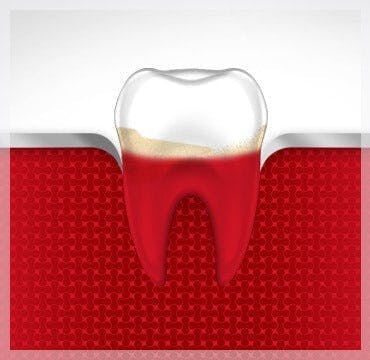Symptoms of Gum Cancer
Gum cancer—a form of head and neck cancer—occurs when the cells in your gums begin to grow out of control and form lesions or tumors. Symptoms of gum cancer are often mistaken for gingivitis or gum disease.1 Thankfully, gum cancers are highly curable when caught early, and visiting your dental professional regularly can help them identify any issues.1 Here are some symptoms of gum cancer to look out for and risk factors to avoid.
Signs and Symptoms of Gum Cancer
You may want to speak with your dental professional about completing an oral cancer assessment if you notice any symptoms. Symptoms of oral cancer or gum cancer can include:
- Red, white or dark patches on your gums1
- Areas where your gums are thicker1
- Bleeding gums1
- Cracked gums1
- Speckled patches on your gums2
- Ulcers2
- Anything growing outward from the surface of your gums3
- Abnormal masses along your gums3
If you notice anything that seems to be questionable or causing you concern, don’t hesitate to reach out to your dental professional so that they can assess the problem.
How Is Gum Cancer Treated?
Gum cancer treatment can involve surgery performed by an oral surgeon.1 The surgeon will assess the area and determine the best course of treatment, which may mean removing the infected area with the goal of curing your cancer, preventing any recurring cancer and maintaining the appearance and function of your mouth.1
However, gum cancer treatment varies depending on the severity and location of the cancer. Treating cancer in the upper gums usually involves a maxillectomy, or a surgery on the roof of the mouth to remove the cancer.1 Cancer in the lower gums can require a surgery called a mandibulectomy—a procedure that removes cancer along the jawbone. Lastly, any inflamed lymph nodes in your neck may require neck surgery.1
More advanced gum cancer may be treated with head and neck radiation therapy, chemotherapy or some combination of the two.1 This can help shrink the tumor before surgery and prevent the cancer from returning. Some patients may only require head and neck radiation treatment to get rid of their gum cancer.1 Any treatment should be determined by the oral surgeon, while consulting with you.
How Is Gum Cancer Different from Gingivitis?
Gum cancer is sometimes mistaken for gingivitis, as symptoms of gum cancer can sometimes mimic symptoms of gingivitis.1 However, there are differences between gum cancer and gum disease that dental professionals look for during your visit.3 It’s also important to note that gingivities and periodontitis are not forms of gum cancer.
Generally, gum cancer involves an abnormality, like a mass, growing outward from the gums. These masses can be red or white and even bleed.3 On the other hand, gingivitis is an infection in the gumline that causes irritation instead of tissue growth. The bacteria that cause gingivitis live there naturally and create irritation.3 Lastly, gingivitis can usually be prevented with good oral hygiene.3
Periodontitis is a form of gum disease that develops after a patient has already had gingivitis for a long time.3 Without treatment, periodontitis can lead to additional gum and jawbone problems.3
Does Gum Disease Cause Gum Cancer?
Although the data is still unclear, gum disease isn’t shown to cause gum cancer.3 However, both gum cancer and gum disease share a common risk factor: smoking and tobacco use.3 Lastly, and on a rare occasion, individuals have seemingly developed gum cancer from poor oral hygiene without any other identified risk factors.3
What Causes Gum Cancer?
Things like tobacco products, particularly chewing tobacco, along with excessive alcohol consumption can increase your risk of developing gum cancer.1 Extremely poor dental hygiene may also increase your risk for gum cancer.1 Lastly, poor fitting dental appliances can rub against your gums and create callouses that look like gum cancer.3 However, more research is still needed to determine if trauma from dental appliances and poor oral hygiene can lead to gum cancer.3
The Importance of Regular Visits to the Dentist
Visiting your dental office at least twice a year is an important component of good oral hygiene.2 Dental professionals are often the first individuals to notice signs of gum cancer, typically during a routine exam.1 Therefore, regular dental checkups are the key to spotting dental issues early.2
To learn more about oral health and gum disease prevention, check out more articles on our Gum Health hub.
SOURCES
- Gum Cancer. Memorial Sloan Kettering Cancer Center. https://www.mskcc.org/cancer-care/types/mouth/types-mouth/gum. Accessed 8/22/24.
- How your dentist can help with oral cancer prevention. MD Anderson Cancer Center. https://www.mdanderson.org/publications/focused-on-health/how-your-dentist-can-help-with-oral-cancer-prevention.h29-1593780.html. Accessed 8/22/24.
- Cancer of the gums: 9 things to know. MD Anderson Cancer Center. https://www.mdanderson.org/cancerwise/cancer-of-the-gums--9-things-to-know.h00-159615489.html. Accessed 8/22/24.





